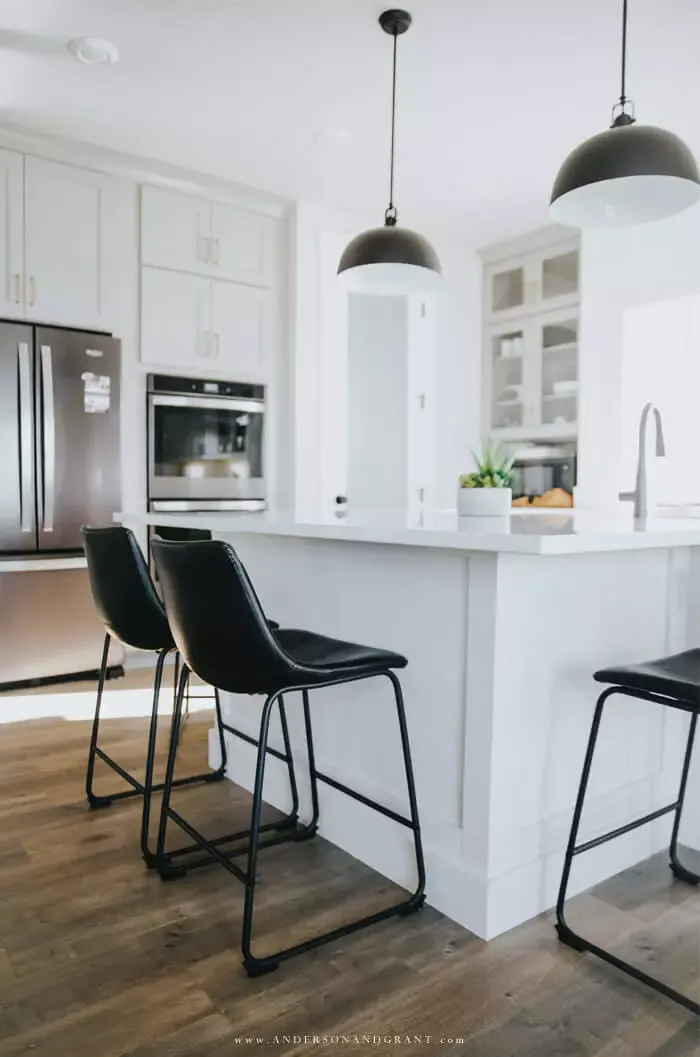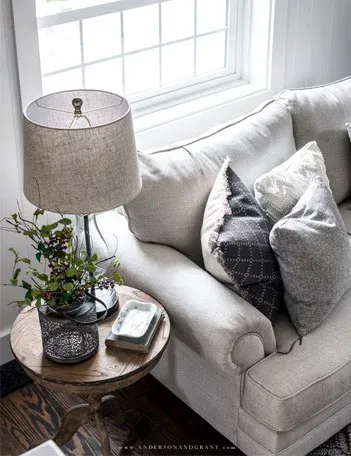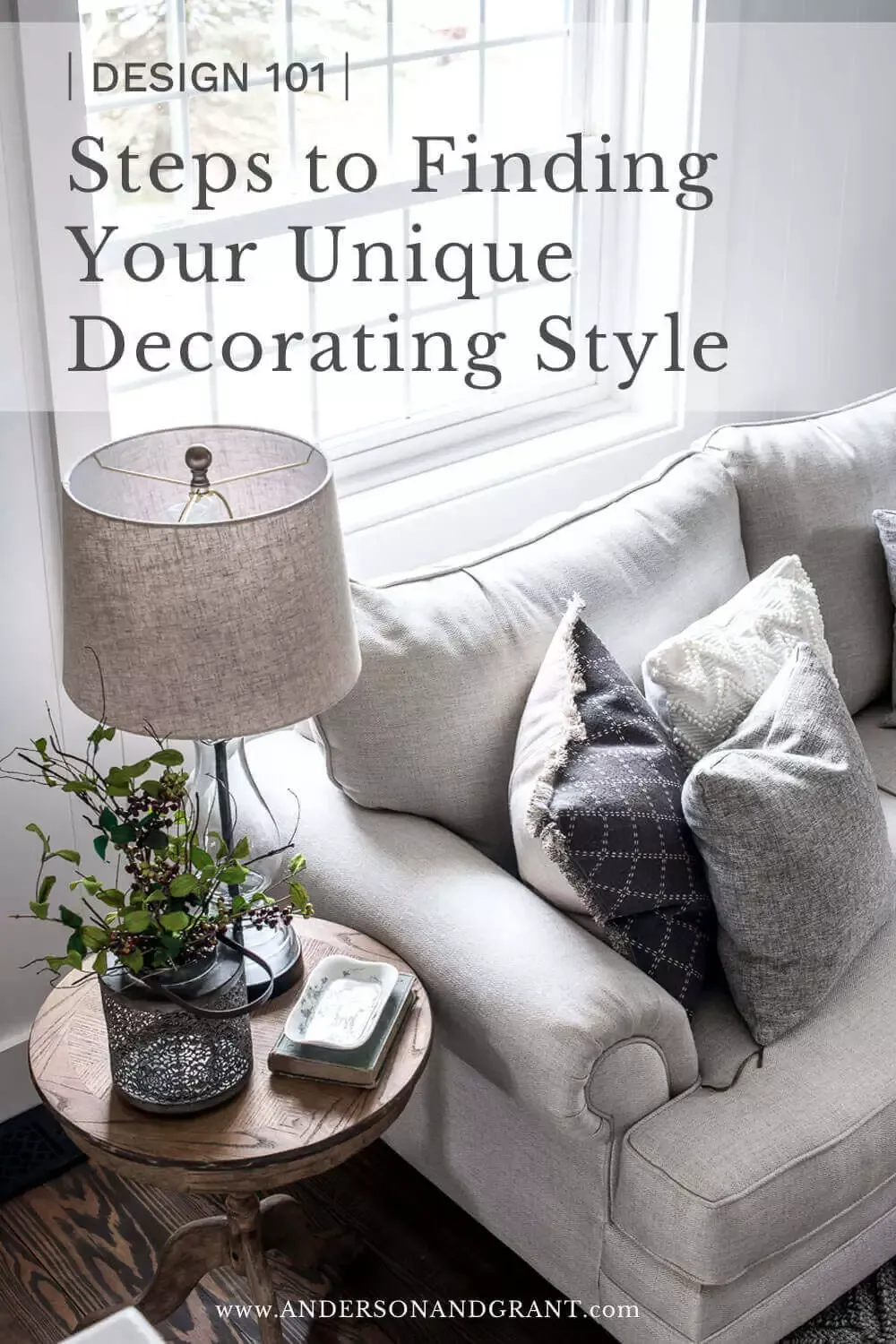Understanding your personal decorating style is about more than just giving it a name like farmhouse or rustic. It's about the feelings you want to invoke in your home and your favorite design elements that collectively create your unique look. This post takes you step by step through the process of uncovering your design personality.
DESIGN + STYLE | Updated March 24, 2023

Discovering your decorating style isn’t something that can be done in an afternoon or without some serious thought.
But it is the difference between having an effortlessly decorated home you love verses making costly, time-consuming mistakes to get a space that “kinda, sorta comes together” in the end.
Taking the time to think through what the elements of your style are and how they coordinate gets you to feeling like your purchasing decisions make sense, you’re confident in what you’ve designed, and you actually like and are happy in the space you’ve created.
You can appreciate a lot of different styles, rooms, and designs, but that doesn’t mean that they are your individual style. It is easy to be drawn into all different trends that you get tired of or never actually feel like you.
Finding ways to incorporate new things without getting too far away from what you know works is important. If shiplap is the trend maybe you have to paint it dark to fit in with your moody style. Or if herringbone tiles patterns are in, you need to choose a tile that fits in with your home’s style over what everyone else is using.
Finding your style is the first step in successfully transforming your house into a decorated home that you love to be in.

DISCOVERING YOUR DECORATING STYLE
What Does It Mean to Find Your Style
There are plenty of quizzes and posts that will tell you to pick three words to describe your style to be able to choose décor and decorate with confidence. But finding your style is not about putting a name on your favorite look, like Modern Farmhouse or Shabby Chic.
Uncovering your style personality goes much deeper. Your style is a combination of the textures and materials you love, colors that draw you in, shapes that please your eye, and the feelings those things invoke. Your style preferences are also influenced by your culture, experiences, and your family’s personality. To put it simply, your style is all about designing your home with things you love and that have meaning.
While each named style has certain characteristics you may find appealing, they are broad descriptions and can’t fully encompass your own unique style and how all those elements come together.
Your actual style is timeless. While the things you love being surrounded by will change and adapt over time with the trends, the basis of your design style will likely stay about the same.
For example, if your style personality is one that truly enjoys adding antique accents to your home for the character they provide, it isn’t likely that three years from now you’ll be ridding your home of all things old. The vintage finds you use may change, but you’ll still crave that décor from the past in some way.
Just to be clear…. You can have your own style even if you are just starting out, living on a budget, or using hand-me-downs and thrift store finds. These situations are temporary, but they don’t have to feel like you’re just making do. Regardless of your life situation, you should still feel like you love where you live and what you are surrounded by. Things don’t have to be expensive or permanent. A little paint or sanding, changing out fabrics, or other DIY makeover tricks can make things fit right in.

Why Naming Your Style Isn’t Important
Most people like more than one style and you’ll find that the most interesting homes are layered with elements from multiple styles to create their own look.
Putting a name on a style puts you into a box, like if you are French Country, you best not stray into the industrial section of Hobby Lobby. And that’s not true at all. While you’d never want to buy random new pieces, there is nothing wrong with using different styles of décor together.
Naming your style will do nothing more than allow you to succinctly describe it to other people or to do an easy search on Pinterest for rooms you might like.
It is more important to know what individual elements you love (i.e. brass hardware, hardwood floors, white walls, handmade baskets) to create your own individual style that feels meaningful to you.
Choosing elements over a name is also helpful when trying to mesh your style with your family. Are there things they love that will match up to your preferences as well?

Benefits of Knowing What You Love
The rewards of being able to describe your design style are worth the investment of time you’ll put into figuring it out. It is your guide to helping narrow down colors you love, furniture styles that fit, and even stores where you should shop.
| DESIGN CHOICES YOU MAKE ARE EASIER
You’ll no longer have to second guess whether or not something is right for your home or if it will work with what you have. Being clear about your style means that you know what you want and don’t want before you even start shopping. No more overthinking or regrets. You can appreciate the beauty and charm of different décor while knowing that it isn’t right for you.
| YOUR HOME WON’T SUFFER FROM IDENTITY CRISIS
Do you ever look around your house and feel like it doesn’t know who it is trying to be? You’re a little industrial in the kitchen, shabby chic in the bathroom, and your bedroom is still stuck in the 90s. You’ve collected so much over time following the trends and your decorating whims that none of it seems to make sense together now. Following your design style helps your home feel cohesive and unified.
| REDECORATING IS EASY
When your home is coordinated, it is easy to switch out your living room pillows and put them in the guest room or move the bench at the end of your bed to the entryway. There isn’t a need to keep buying new things for your home to look fresh. Everything you buy will likely be able to be used throughout your home.
| LESS TIME SHOPPING
You may love shopping for new things, but probably don’t like being overwhelmed by all the options. Once your style profile is narrowed down, you can limit your searching to just those things that you know are viable choices.
For example, when looking for a new rug, you are met with hundreds or thousands of choices from a variety of websites in all different colors, patterns, and materials. But, if you’ve realized that you have a thing for vintage (or looks-like-vintage) rugs and you gravitate towards neutral colors, you’ll only need to search for those criteria.
| SAVES YOUR MONEY
How often have you randomly bought something you thought you loved only to get it home and realize it isn’t as great as you thought? That it doesn’t fit in with anything you have in your home? And of those times, how many times did you actually take it back to the store?
With all the online shopping now, it is even harder to return what doesn’t work. So ,you’re stuck with it and out the money spent. After deciding on your decorating style, you’ll have a filter to avoid those buying mistakes.
| YOUR CONFIDENCE GROWS
Finally, and maybe most importantly, being clear about what is and isn’t for you in the home leads to feeling more confident in your abilities and proud of what you’ve put together. You know that it is all a mix of the things you love and your home feels the way you desire.

4 Step Technique to Discover Your Unique Decorating Style
STEP 1: INVENTORY YOUR HOUSE
Your home holds a lot of clues to what your decorating style is, even if there is a lot that you don’t like.
Spend some time in each room and focus on the following questions. Answer in as much detail as possible because it will help you know what you want to add more of and what you want to stay away from. Keep your responses in a notebook.
| LOOK FOR WHAT YOU LOVE AND WHAT IS WORKING
- What do you love about this room? How does it make you feel when you’re in it?
- What furniture is your favorite and why? Is there something the pieces have in common (color, style, sentimental, functional, etc)?
- What are your favorite accessories and why? Again, what do they have in common?
- Do you love the colors, patterns, and textures in the space?
- What is your favorite thing about this room?
| NOW FOCUS ON THE THINGS YOU DON'T LOVE OR AREN'T WORKING
- What doesn’t feel like you?
- What bothers you about this space? (Layout, furniture, accessories) What do these things have in common?
- What would you like to see taken out of this room? (This includes things like family heirlooms that aren’t in the space because you chose to put them there.) Why do you not like these things? What has held you back from changing them before this?
- What colors, patterns, and textures don’t you love in the space?
| ANALYZE YOUR FINDINGS
- Once you’ve gone through the house, sit down with your notes. Make a list of the things that you loved, like the materials, colors, textures, furniture, and accessories. These are elements that you need to include when you decorate.
- Do the same for the things that you said you didn’t like. These are elements that you need to avoid buying in the future and need to limit when you redecorate. Obviously, certain things are sentimental to you or a family member, so while removing them may not be an option, you can likely find ways to better make them work so that everyone is happy.
Being clear about what you don’t want is just as important as uncovering the elements you do.
STEP 2: HOW DO YOU WANT TO FEEL?
The way you want to feel in your home and in specific rooms is crucial to defining your decorating style. While style words like Farmhouse and Boho won’t help much when knowing if décor and furniture is right for your unique look, feeling words like Simple, Inviting, Timeless, and Open can be felt when shopping.
For example, if you say that you want your home to feel calm and peaceful, you’ll know to stay away from things like crazy patterns and bold colors when picking out décor. Or if you want your home to feel cozy, you’ll gravitate more towards texture and warmer colors over bright white and polished.
Keep a running list in your notebook as you think of ways you want to feel.

STEP 3: GATHER INSPIRATION
Now is the time to step away from your current reality and take a look at what inspires you. Keep in mind that the images you collect are just leading you in the direction of your style profile and not to copy anyone else. You are trying to find your own unique look, and that is sometimes easiest to do when looking at what others have put together.
| SEARCH FOR IMAGES YOU LOVE
Whether you want to start a secret Pinterest board or gather loose magazine pages and images printed from Instagram, spend some time searching for interiors, furniture, and accessories you immediately love. Places you could see yourself living. Chairs you would want to sit in. Artwork you’d hang on your wall. Things that instantly stop you in your tracks and make you feel good. If you hesitate as to whether or not you love it, then you obviously don’t like it enough to include it in this research. Aim for about 30 to 50 images.
Compile your photos over a couple of weeks, getting rid of images that no longer speak to you, and looking at patterns in what you’ve saved. Is there a lot of velvet sofas, white kitchens, or sisal rugs? Maybe you see a lot of dining rooms with benches rather than chairs or brass faucets in the kitchen. Or perhaps you like how the entire space comes together with the combination of furnishings and decor. What you love and see over and over again should be an element of your style.
Write down the similar characteristics in your notebook.
| SHOP YOUR CLOSET
The things you love to wear often share similarities to the things you like to surround yourself with in the home. And unless someone else does your shopping, you are in control of what clothing you buy unlike home goods that you may get the opinions from family members on.
Do you wear a lot of neutrals or do you prefer a specific color? Are you into textures like wool or prefer somethings smooth like silk? Prints or solids? Tailored or loose? What do you like to splurge on?
Do these answers describe how you want your home to be like, too? Can your fabric preferences lead you to picking out something similar for pillows and curtains? If you like loose fitting clothes, do you also want a sofa that you can sink into over something tufted and tailored?
| LOOK AT HOME EXTERIORS
Take a trip through your neighborhood and pay attention to homes that catch your eye. What style are they? Mid-century Modern, Farmhouse? What materials make up their exterior? Traditional brick, Modern vertical siding? Are there details you enjoy like copper gutters or gingerbread trim? Things you enjoy seeing on the outside of the house can lead to making assumptions about the style you’d like to see inside.
It is also important to consider the architectural style of your own home as that will likely guide your decorating decisions as well. If you home is traditional, you will need to pull in some touches that lean that way, even if your style is modern, so that it flows with the things you can’t change. You don’t want your house to feel like it is modern furniture and décor stuck in an old traditional structure.

STEP 4: ANALYZE YOUR FINDINGS
What Are Your Style Elements?
Now that you are done doing your style research, it is time to sit down and analyze what you wrote in your notebook. What things are you going to keep and buy more of? What do you need to stay away from?
It is helpful to think in specifics now in order to come up with a list of elements that you consider your personal style. Some examples to guide you:
- What color and fabric sofa is right for your living room? With that in mind, what texture and color of pillows would look best against it?
- What type and finish of hardware should you buy for your cupboards?
- Do you lean towards patterned rugs or something simple like woven wool or sisal?
- Imagine your walls – Are they decorated with a large abstract piece of art, a series of vintage prints in frames, or a gallery wall of black and white photographs?
- And what color are those walls? Do you have one color throughout the house or coordinating shades in different rooms?
- Think about light fixtures – Are you in to a black matte finish, brass, silver, glass?
- Look at your wood tone preferences – Do you want furniture in light shades, dark shades, or a mix of both?
- Envision your dining table set for Thanksgiving – What do the dishes and centerpiece look like?
Obviously, it is impossible to go through every decorating situation and décor choice here, but really spend some time thinking about the details and come up with a no-fail shopping list of your elements and the feeling you want to convey that you can carry with you when shopping.
For example: Clean and simple, dark wood floors, white walls, marble countertops decorated with aged cutting boards and my favorite cookbooks, white cabinets, black hardware, vintage accents, stripes and simple patterns, brass candlesticks, traditional rugs, comfy neutral sofa, but structured chairs, space for my family to play.

What is Your Preferred Color Palette?
You will want a cohesive color scheme that you can carry throughout your whole house with paint and accessories. This doesn’t mean every room is painted the same color, but rather the colors are repeated throughout the house in different ways and intensities.
- Look for between two to four main colors and two to four colors to use as accents. Most people choose neutrals as their main palette and add pops of colors through accents, but you should choose what speaks to you.
- Choose colors that coordinate together to create flow. (Like you don’t want walls painted red in a room right next to one painted lime green.)

Create a Mood Board to See How It All Comes Together
Finally, put together a mood board showing how your elements look side by side. You can do this digitally or cut and paste images together on a piece of poster board. Whether you are designing a single room or want to see your style across the entire house, it is helpful to have a visual representation of all the things you want to see in your design.

Reasearching your individual style preferences can seem like time consuming work, but you'll know it was time well spent when your home finally feels like you. If you have any interest at all in decorating your home with a "professional" touch, this is the first place to focus before starting to pick out new furniture, textiles, and paint.
READ NEXT: 5 Simple Ways to Uncover Your Decorating Style

